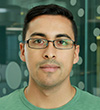Quantum communication and imaging in the Optoelectronics group
Álvaro Cuevas (ICFO)
ABSTRACT:
During last century, the majority of physicists focused their attention onto the fundamental properties of the quantum world at microscopic scales. Their findings gradually turned into proofs of principle experiments, and today we can see practical applications that will pave the way for the upcoming quantum technology revolution.
In this presentation I will show the scientific and technology activities within the Optoelectronics Group at ICFO, where we develop and transform basic concepts into practical technologies for both quantum communication and quantum imaging. The work was mainly developed within four European projects (CIVIQ, QUANGO, OPENQKD and QMIC) and, more recently a project sponsored by the Generalitat (SMARTCAT).
Practical Implementations of fiber-based Continuous Variable Quantum Key Distribution (CV-QKD)
CIVIQ, OPENQKD and SMARTCAT: The aim of these projects is to bridge the gap between academic developments and quantum key-distribution (QKD) implementations for metropolitan fiber networks. In particular, we have focussed on developing compact and robust QKD systems, that can be easily integrated into standard telecommunications networks. CV-QKD system prototypes are now ready to be deployed for filed demonstrations of the technology [1]. We have also collaborated with other partners in designing and testing integrated chip versions of the CV-QKD transmitters that will play a key role in the next generation of low-cost and high performance QKD systems. The technology was also transferred to Luxquanta, a new spin-off incubated at ICFO’s KTT launchpad.
Quantum Transmitters for Space-based QKD
QUANGO: The aim of this project is to design and develop a payload for a LEO orbit nano-satellite with combined payloads of 5G communication and QKD-downlink [2]. We will develop a prototype breadboard version of the quantum payload to implement GHz repetition rate DV-QKD with polarization encoding. The Optoelectronics group is also working in the definition of the QRNG requirements and its integration into the transmitter.
Quantum-enhanced Interference Microscopy
Q-MIC: The aim of this project is to develop a new on-chip differential interference contrast imager based on an unconventional birefringence lens-free configuration, integrated with quantum sources, single-photon image sensors, and using a novel multi-photon image processing. The Q-MIC platform will reach unprecedented sensitivities (a few atomic layers, of the order of 1 Å) over large field-of- view (tens of mm2) in the low light (single-photon) regime. This unique combination of features has allowed to demonstrate label-free phase super-sensitivity and super-resolution of transparent samples beyond classical alternatives and without photo-damage risks [3]. We believe this technology can be used in quality control of micro-fabricated devices and in biomedical sensing of cells, viruses and proteins, making it useful for disease diagnostics.
[1] Grande, IH Lopez, et al. Optics Express 29.10 (2021): 14815-14827.
[2] https://quango.dei.unipd.it/WP.html
[3] Robin et al. Science Advances. 7, eabj2155 (2021) – To be published on 17 November 2021
BIO:
Dr. Álvaro Cuevas is an experimental physicist specialized in quantum optics. He started his career at University of Concepción (Chile), where he obtained a Master’s in Physics for his achievements in loophole-free Bell tests utilizing fiber optics. During that period, he also worked as research assistant at Center for Optics and Photonics (Chile). He continued his career at Sapienza University of Rome (Italy), where he obtained a Ph.D. in Physics for his studies on quantum noisy channels and open quantum systems. During that period, he participated in high impact collaborations; with CNR-NANO (Italy), where he could obtain photon-polariton entanglement; within the Big Bell Test initiative, for providing technical support on experiments with human randomness; and with the Atomic Quantum Optics group at ICFO, for setting up a monolithic/resonant quantum source. Later, he did a post-doctoral period in the Quantum Optics group at Sapienza University, where he worked on experimental implementations of quantum walks and hyper-entanglement engineering. More recently he moved to Barcelona, where he is now working as a post-doctoral researcher in the Optoelectronics group lead by Prof. Dr. Valerio Pruneri at ICFO. In this position he develops quantum-enhanced technologies for practical applications, comprising a variety of activities within different projects; 1) building practical wide field interference contrast microscopes with non-classical optical capabilities; 2) exploring ways to distribute entanglement and multiphoton correlations through turbid media and unconventional waveguides, for both imaging and telecommunication purposes; 3) designing novel and versatile quantum sources for the future quantum internet.

